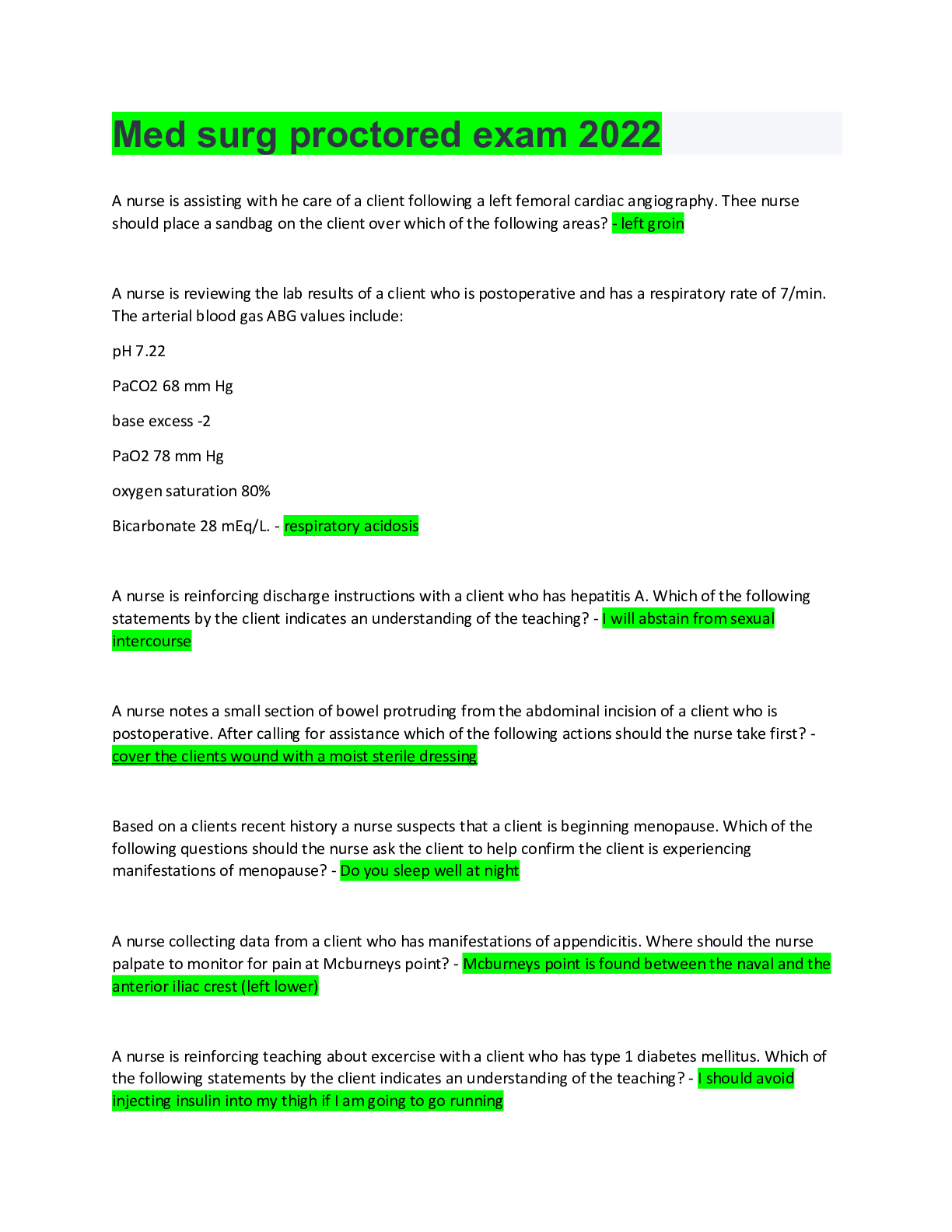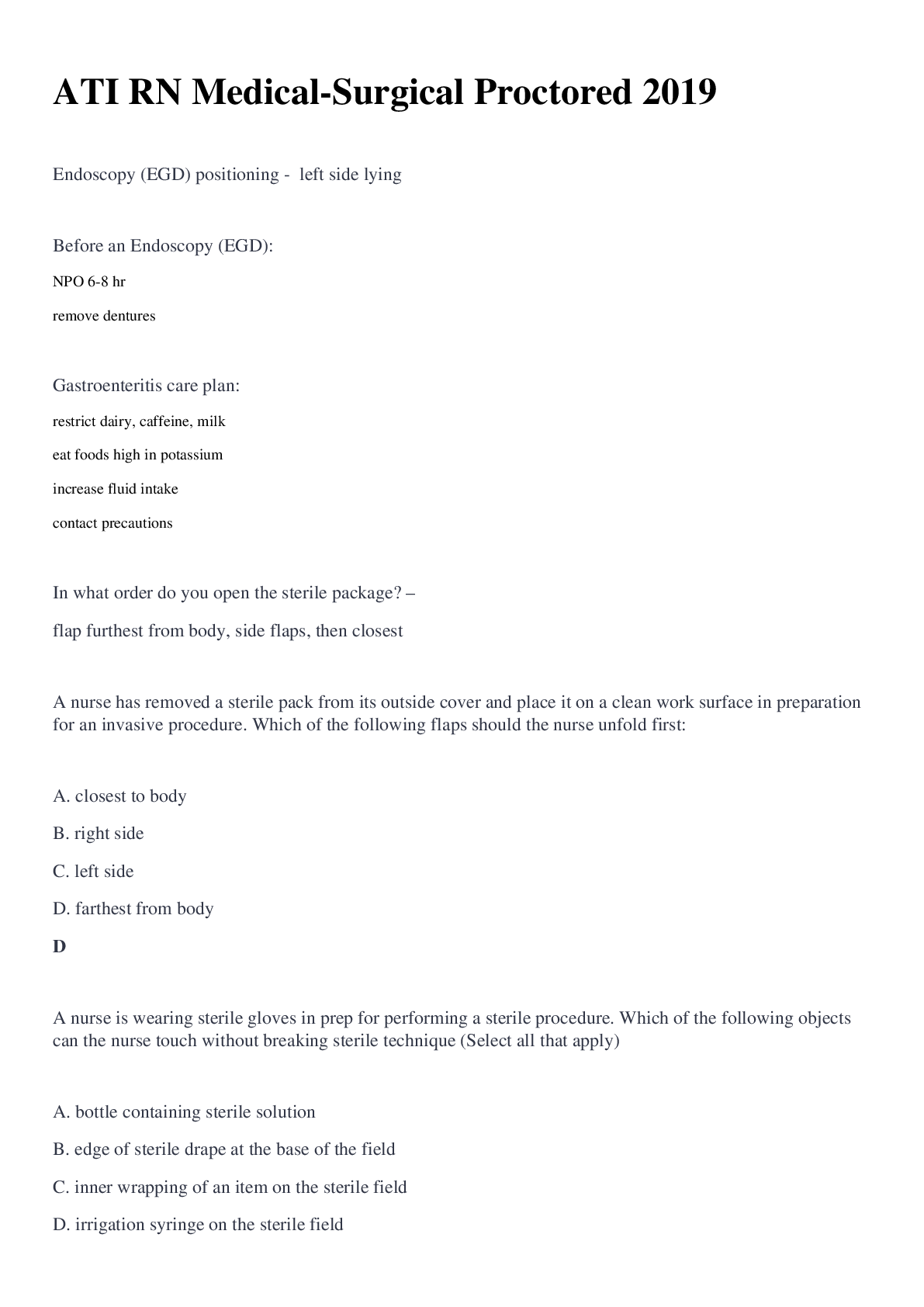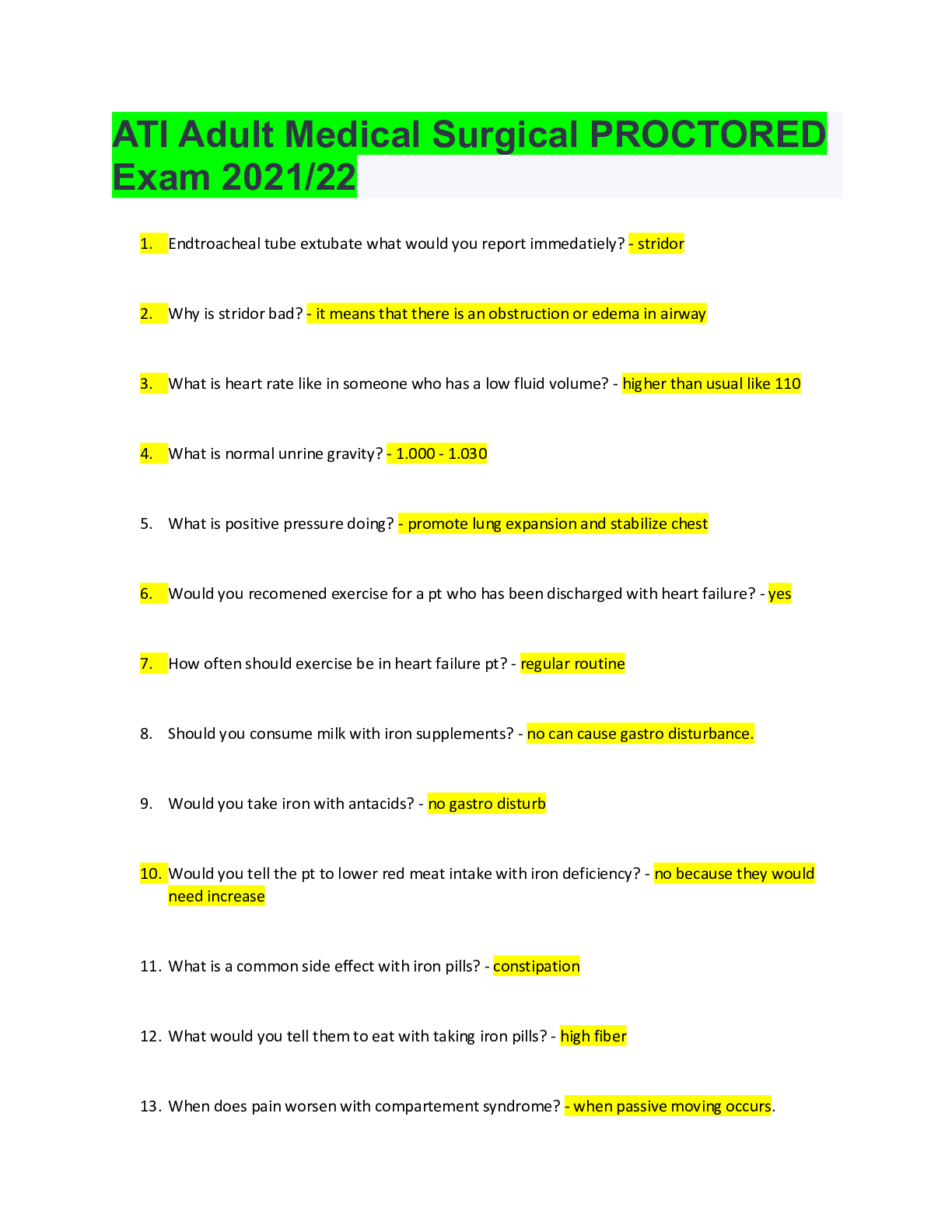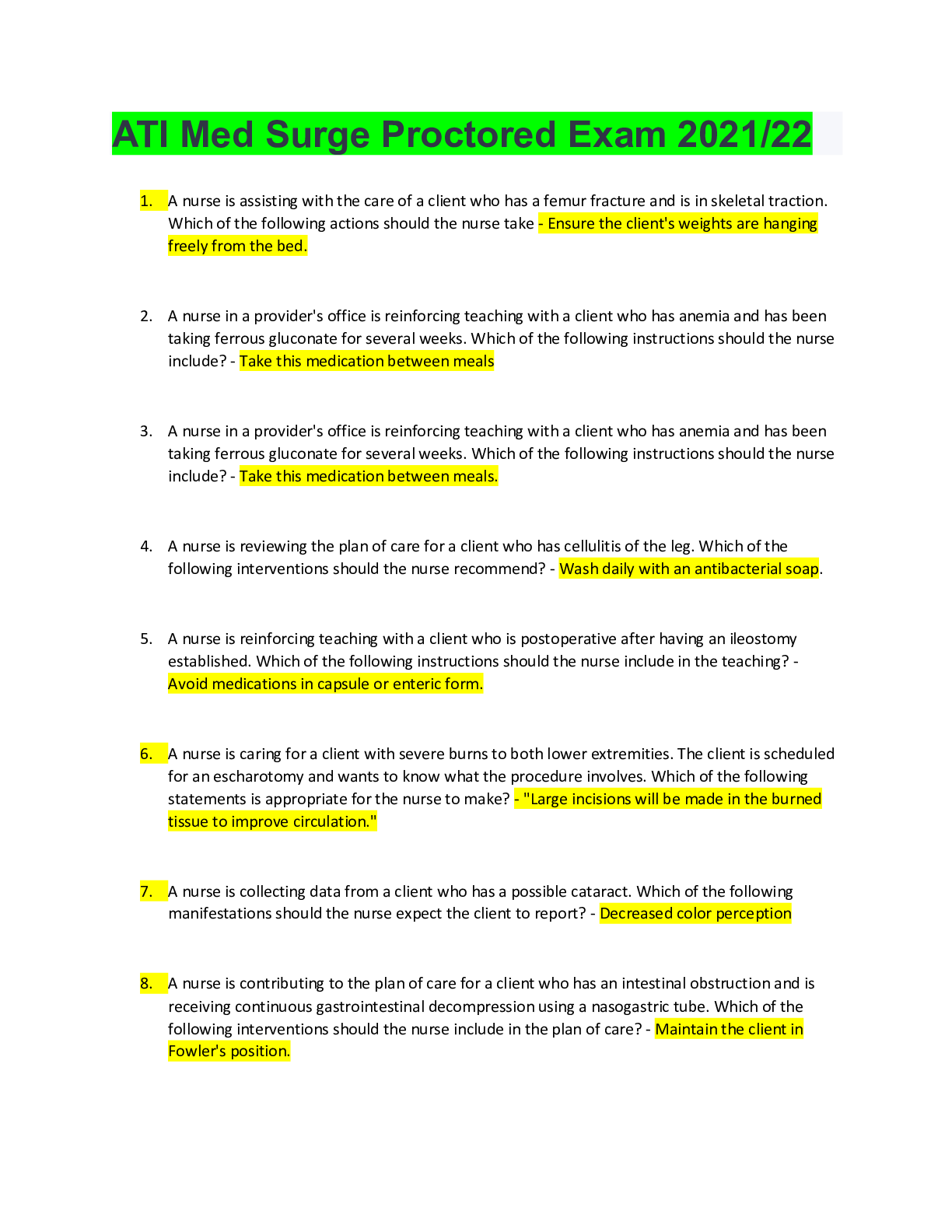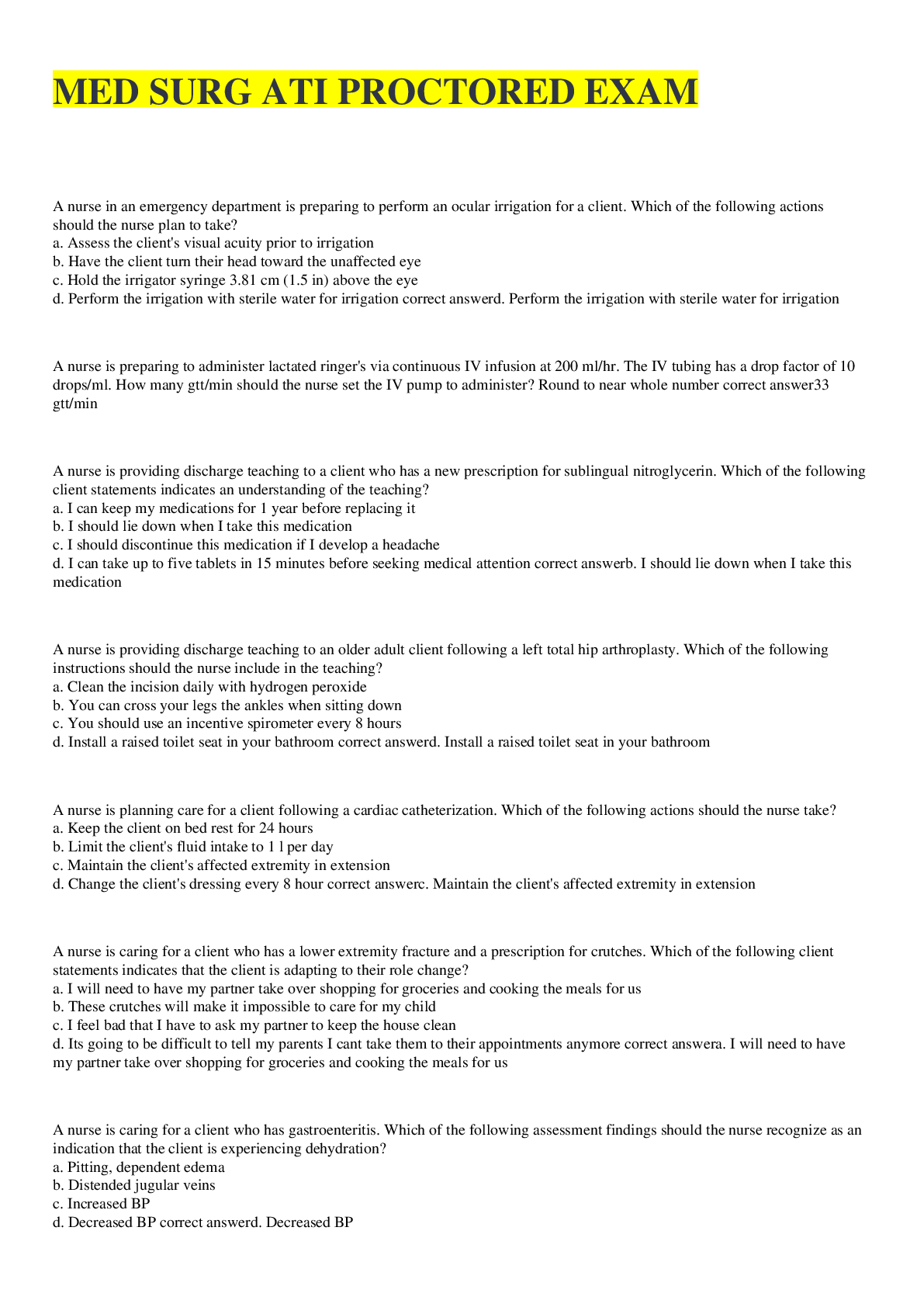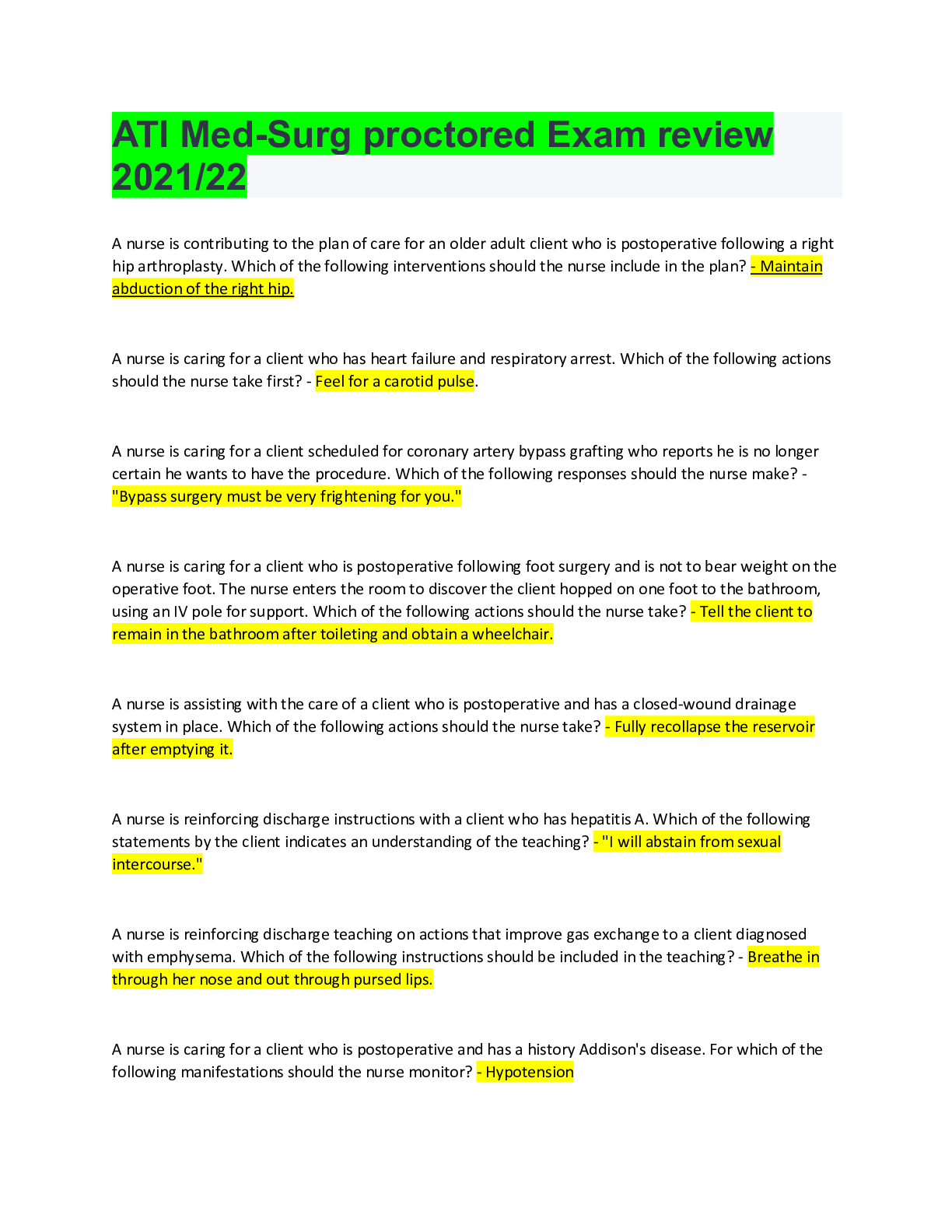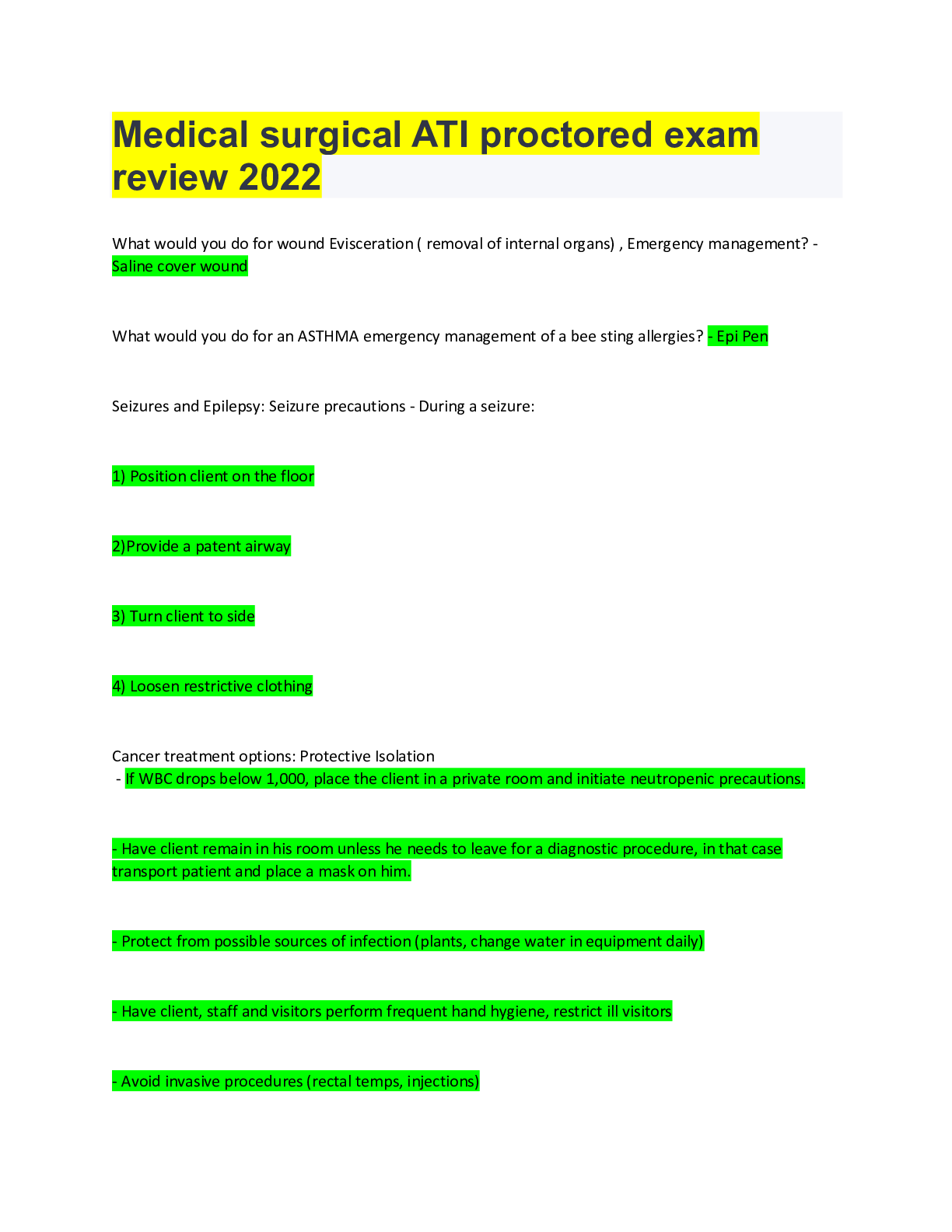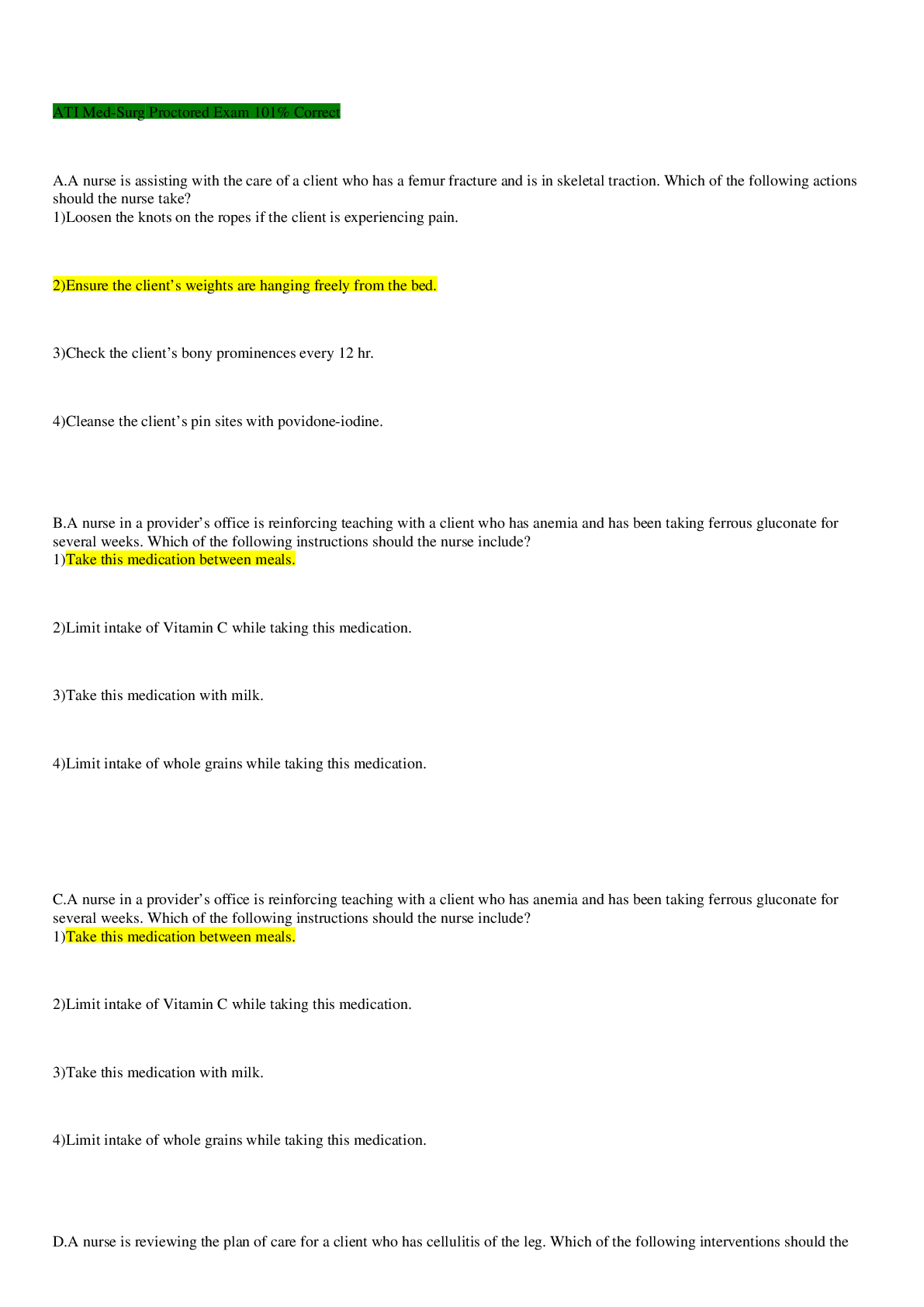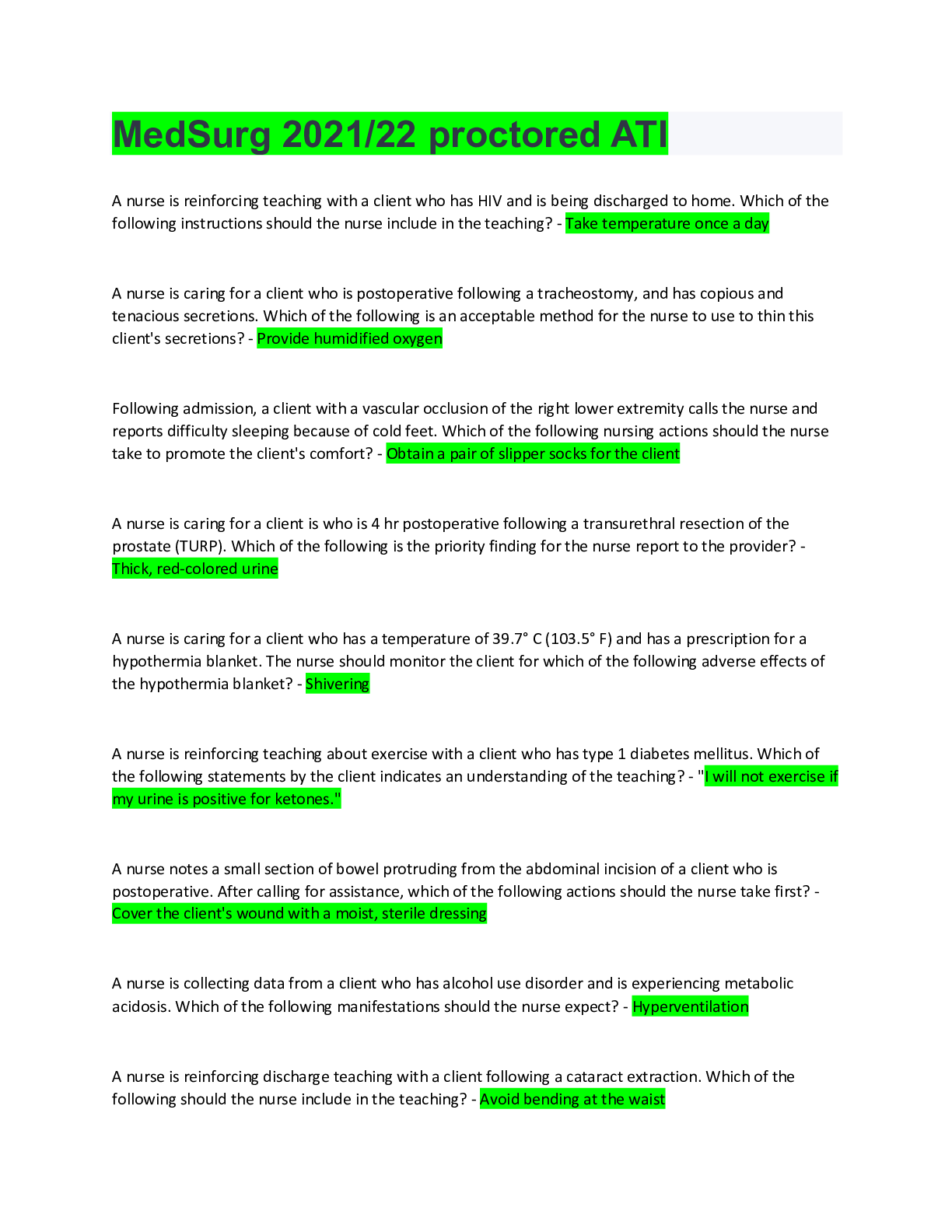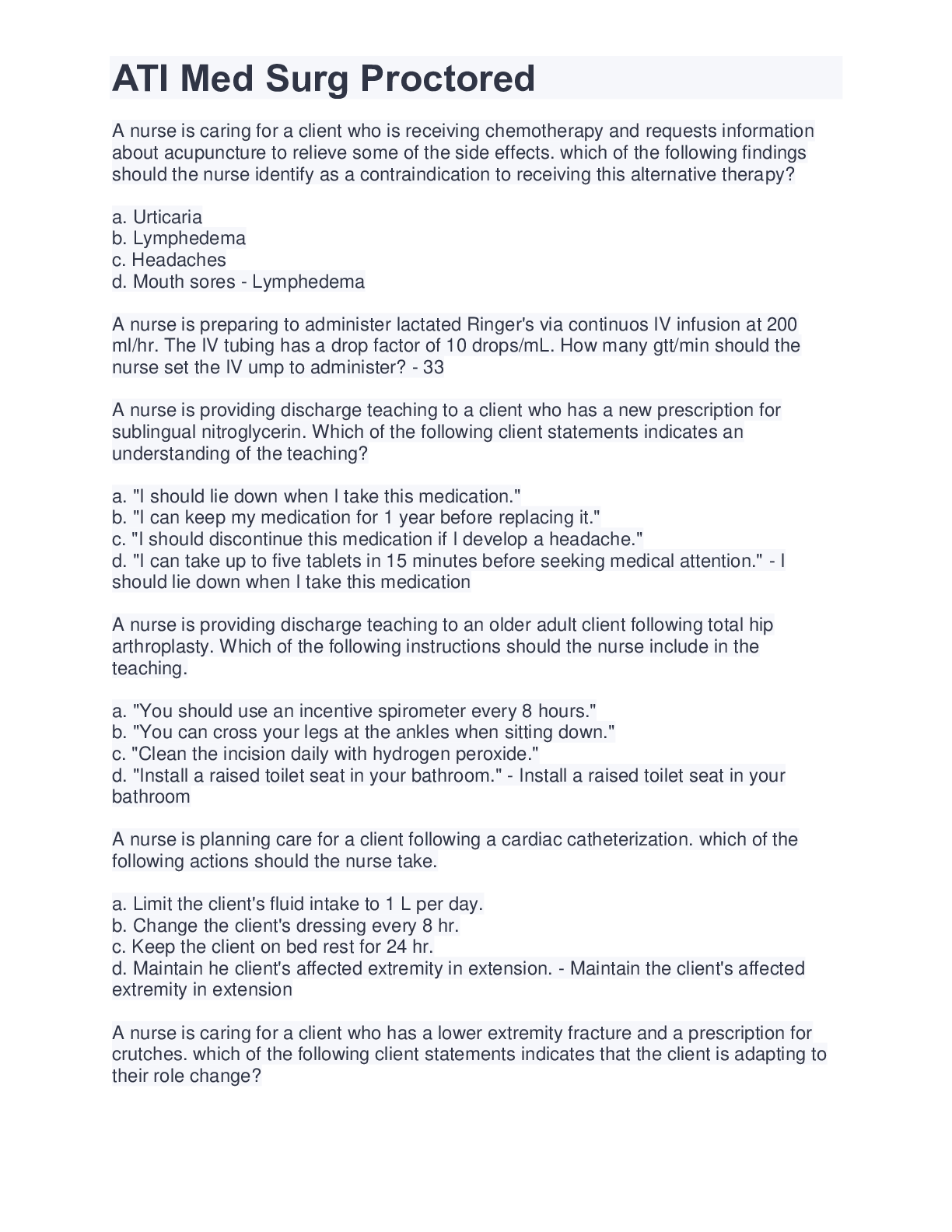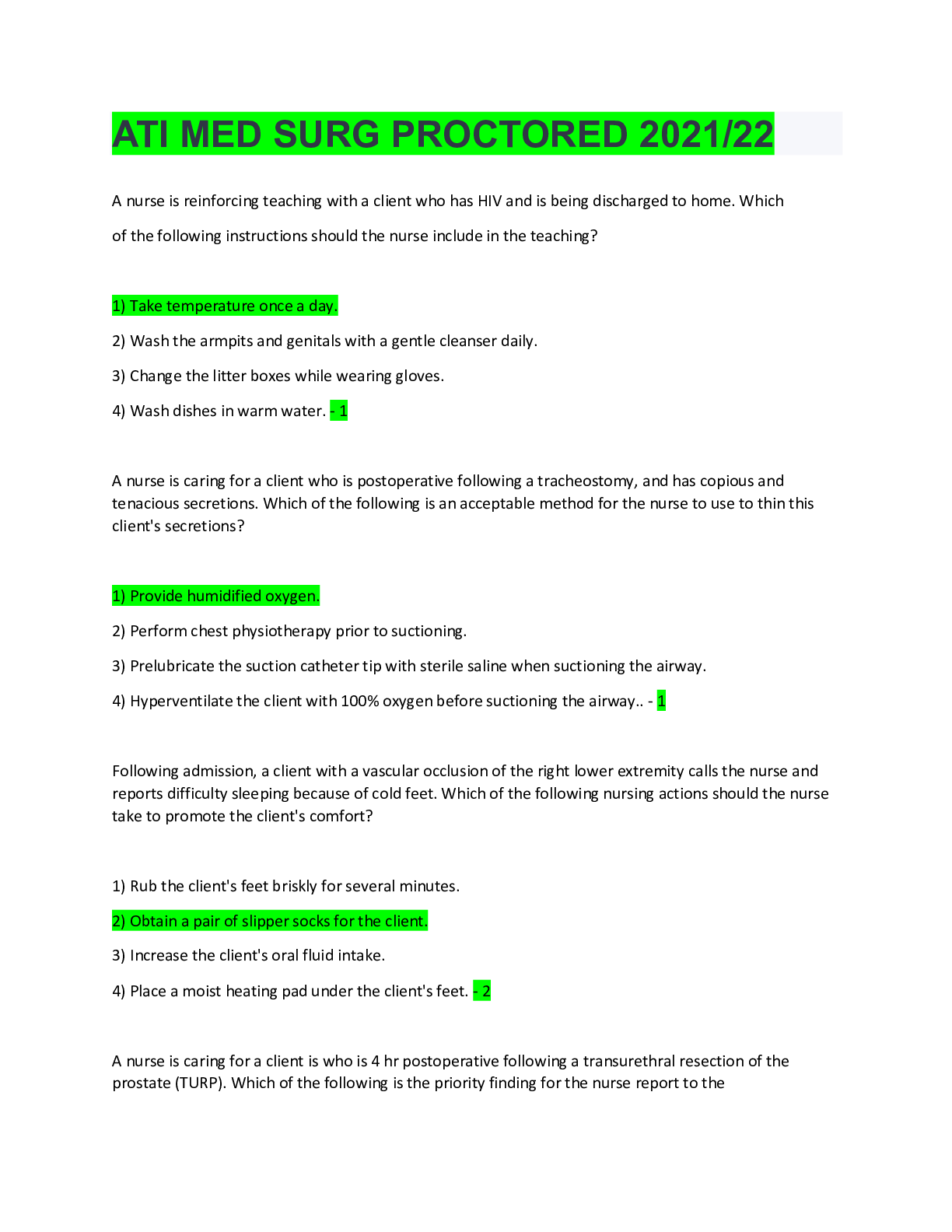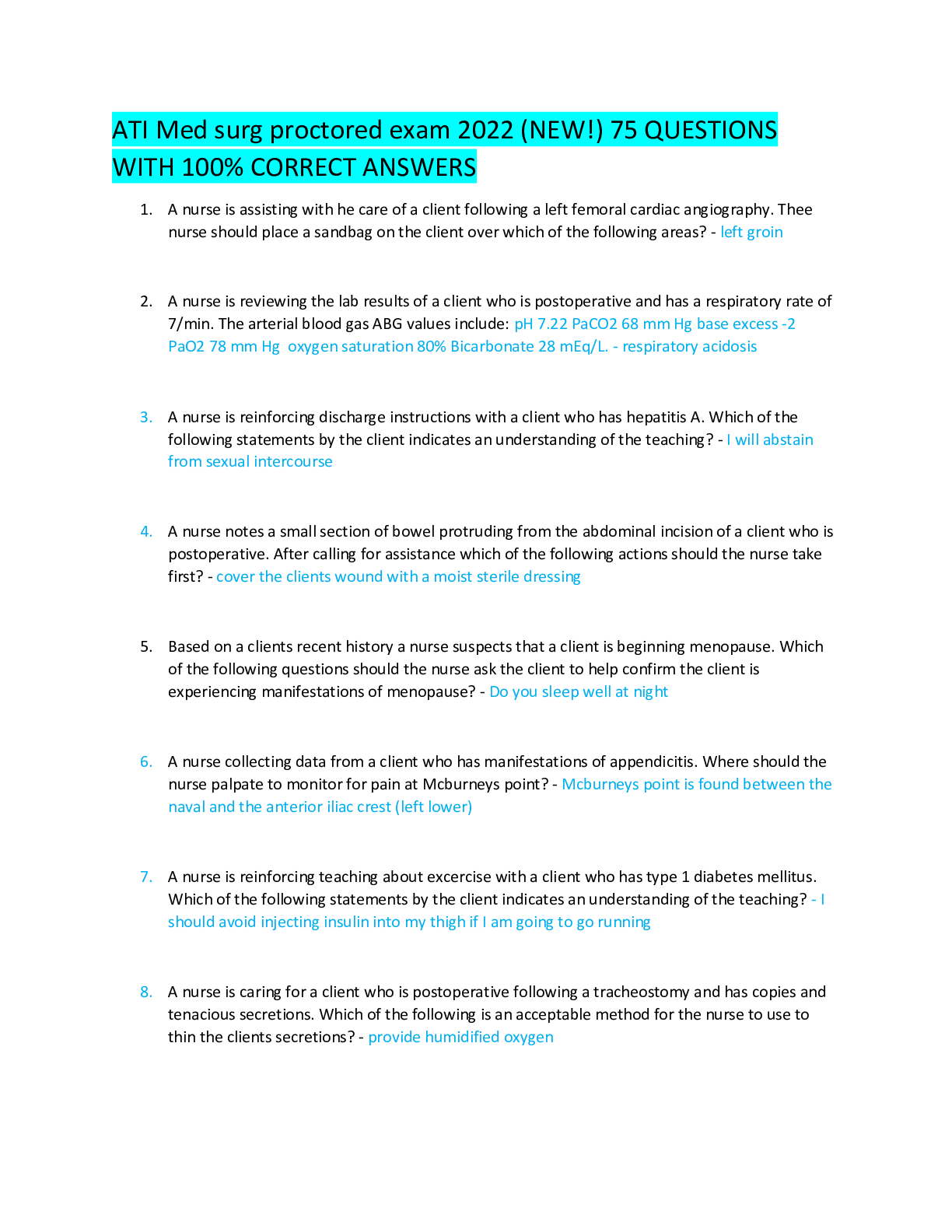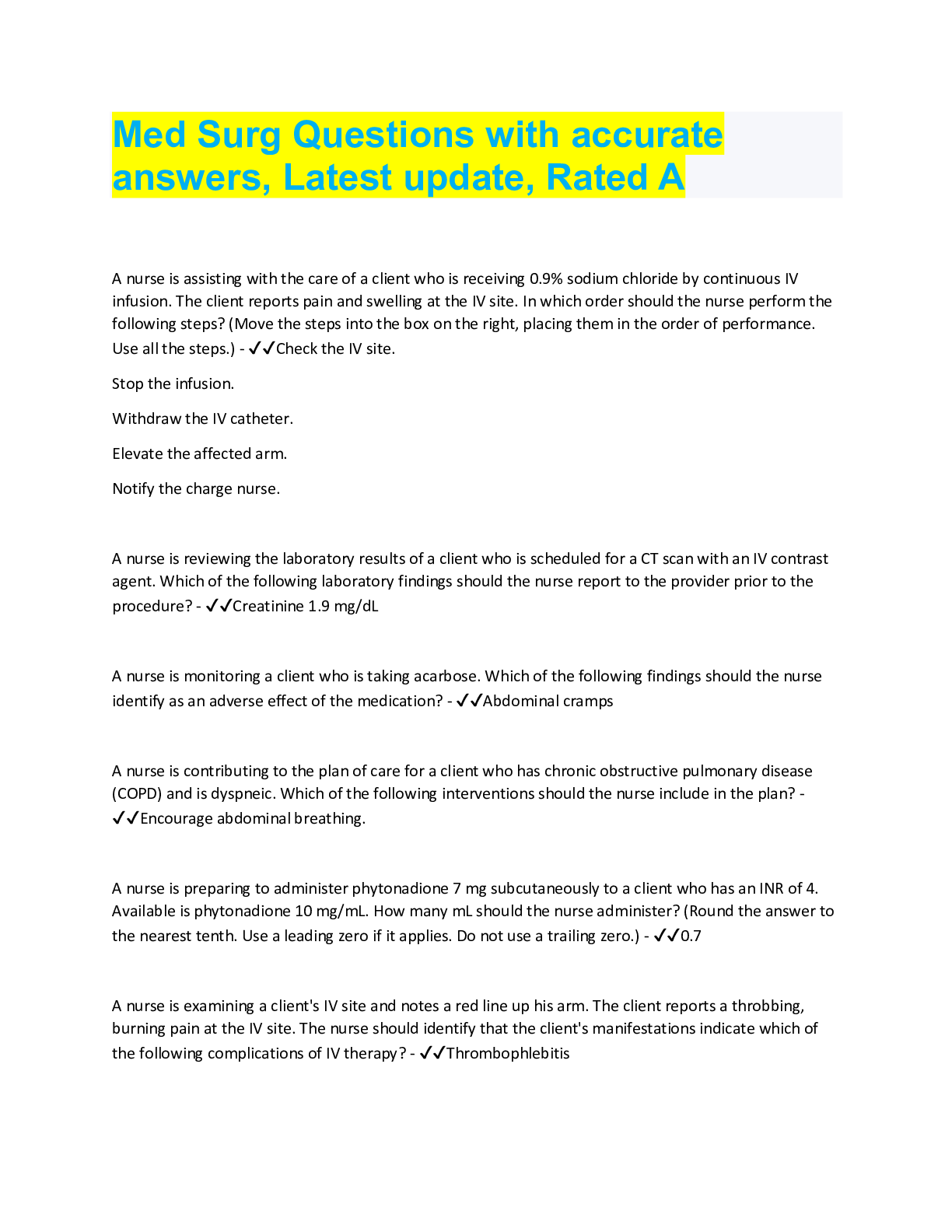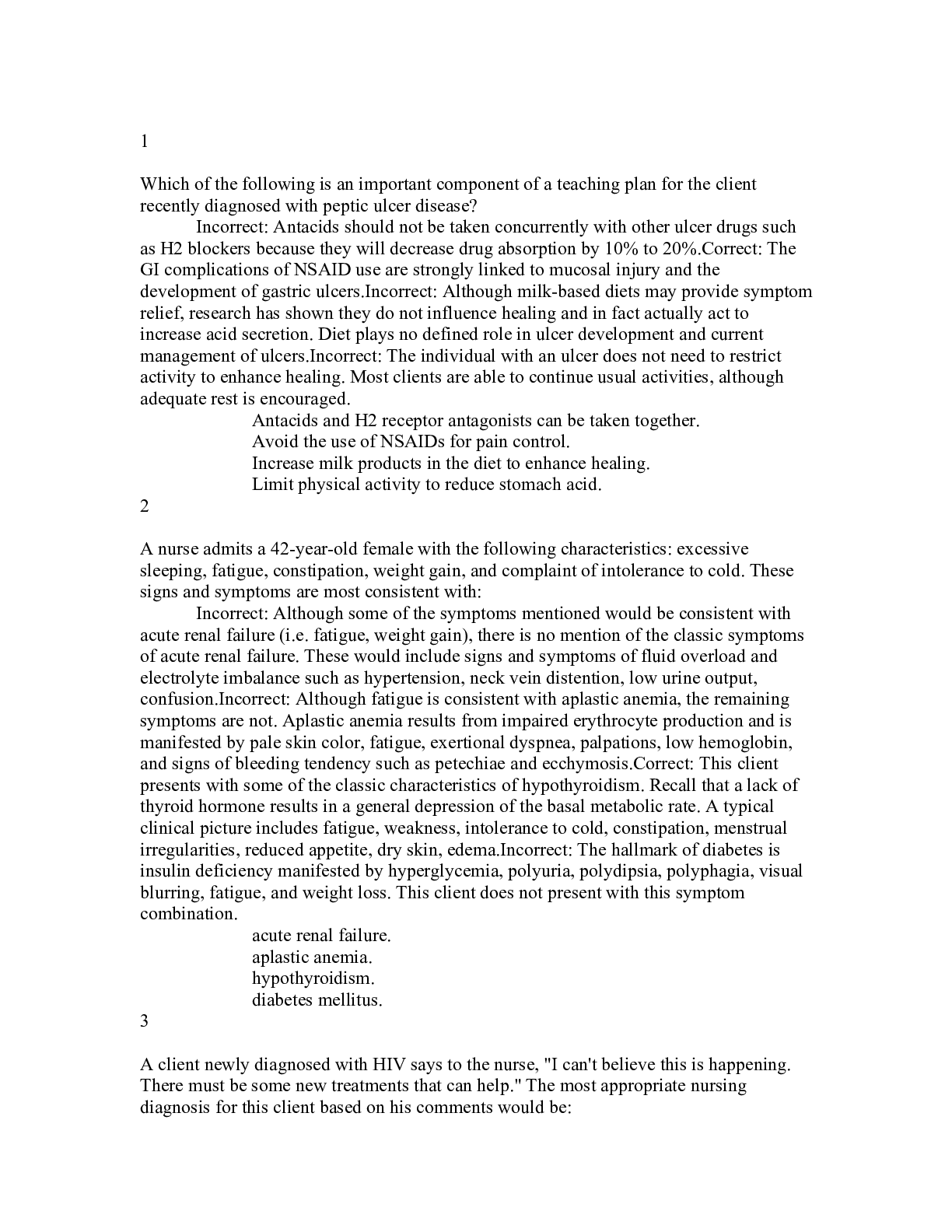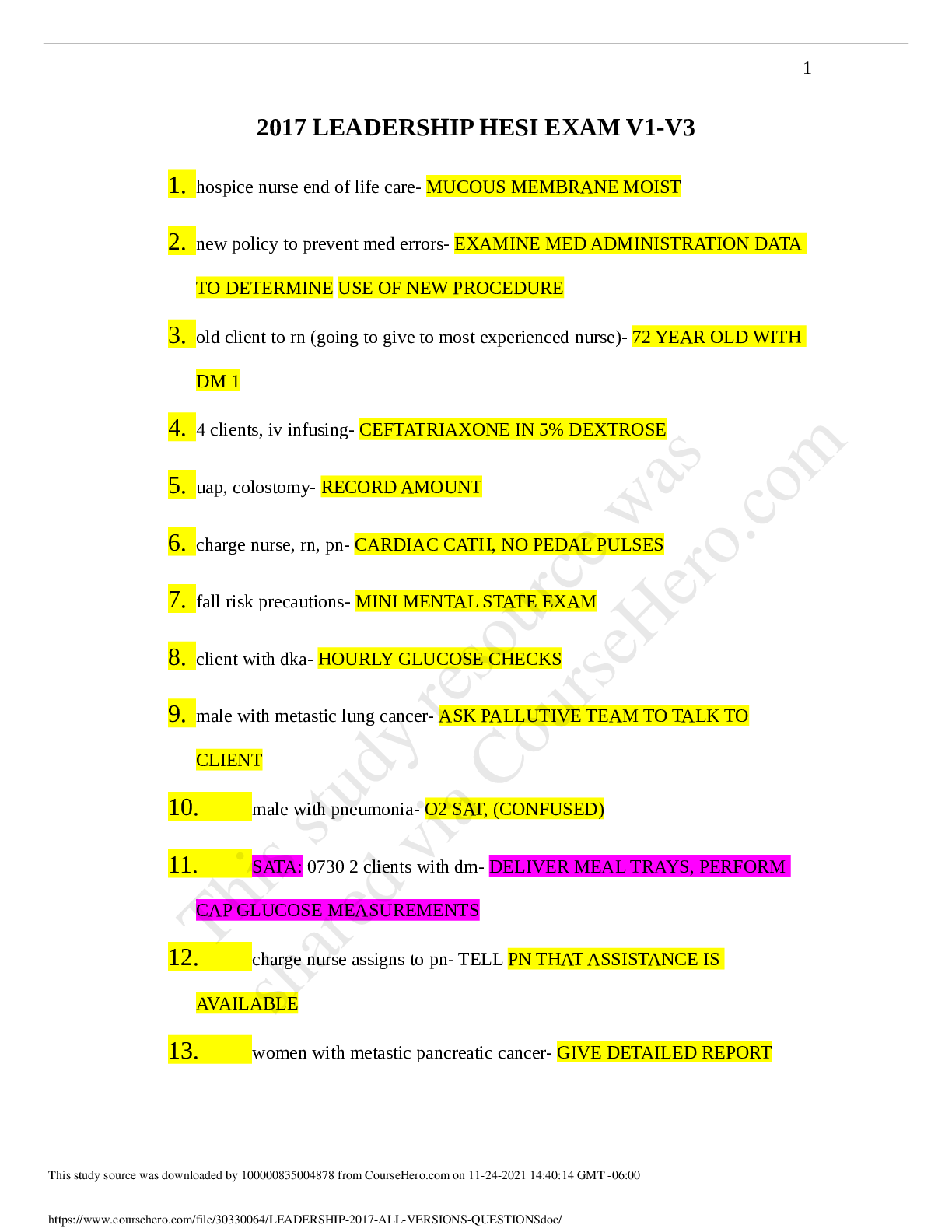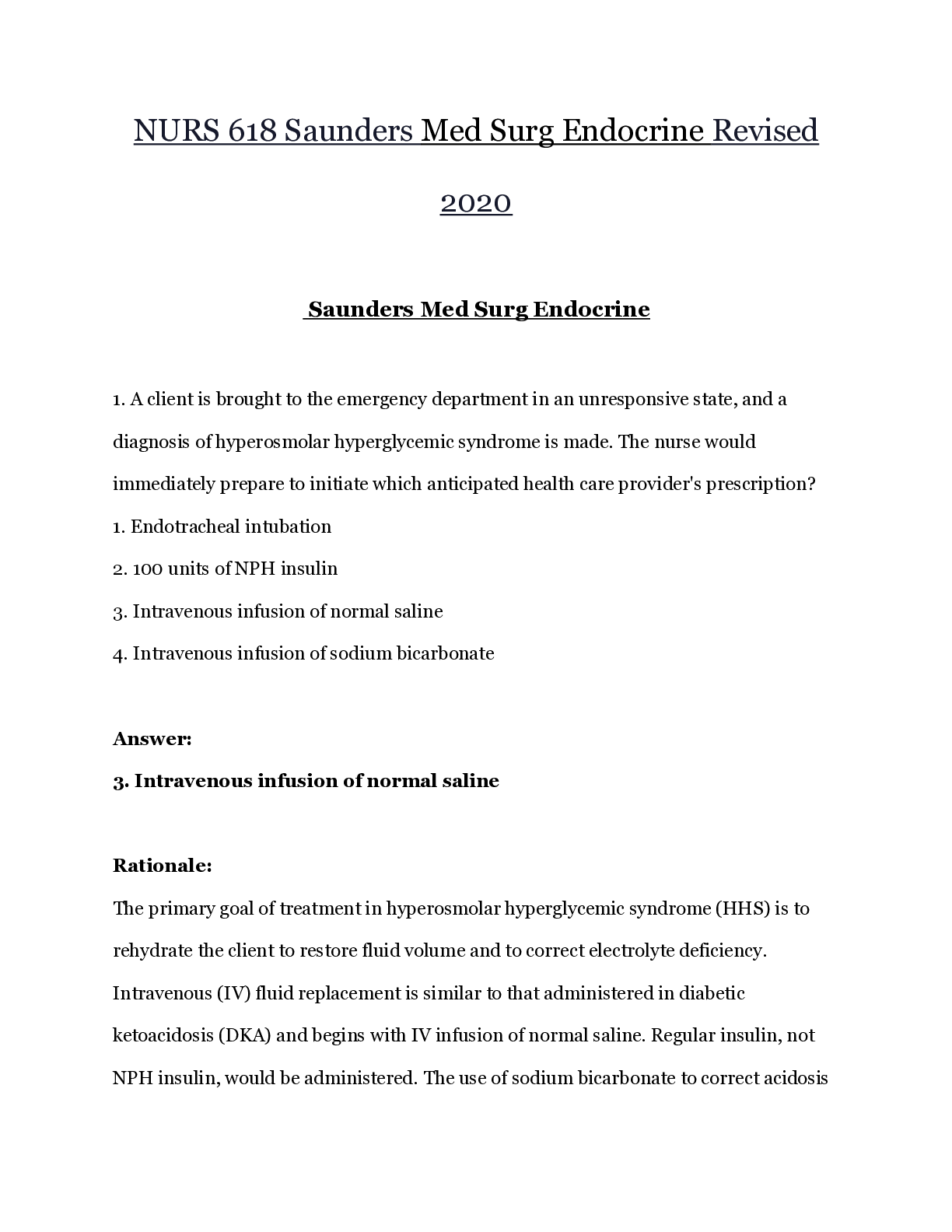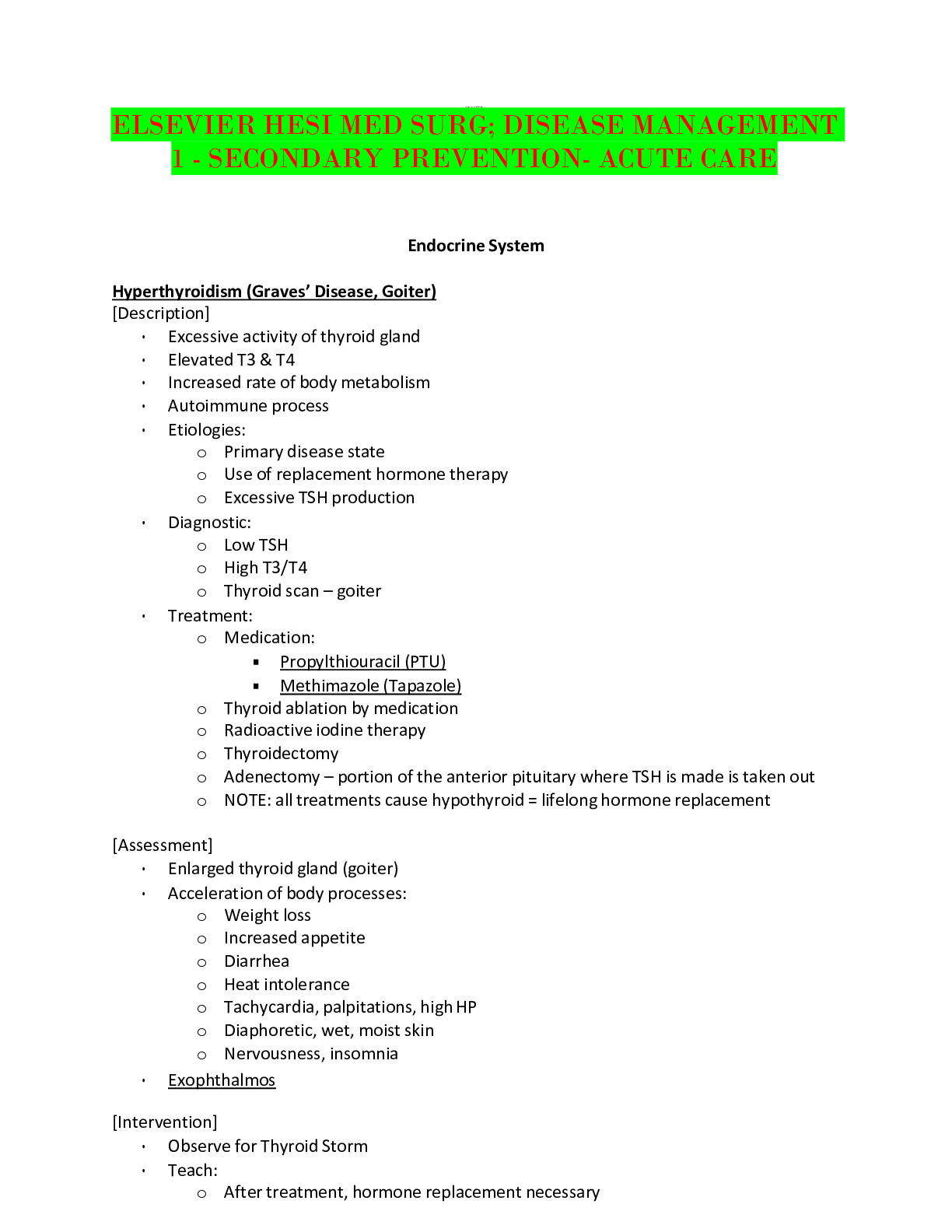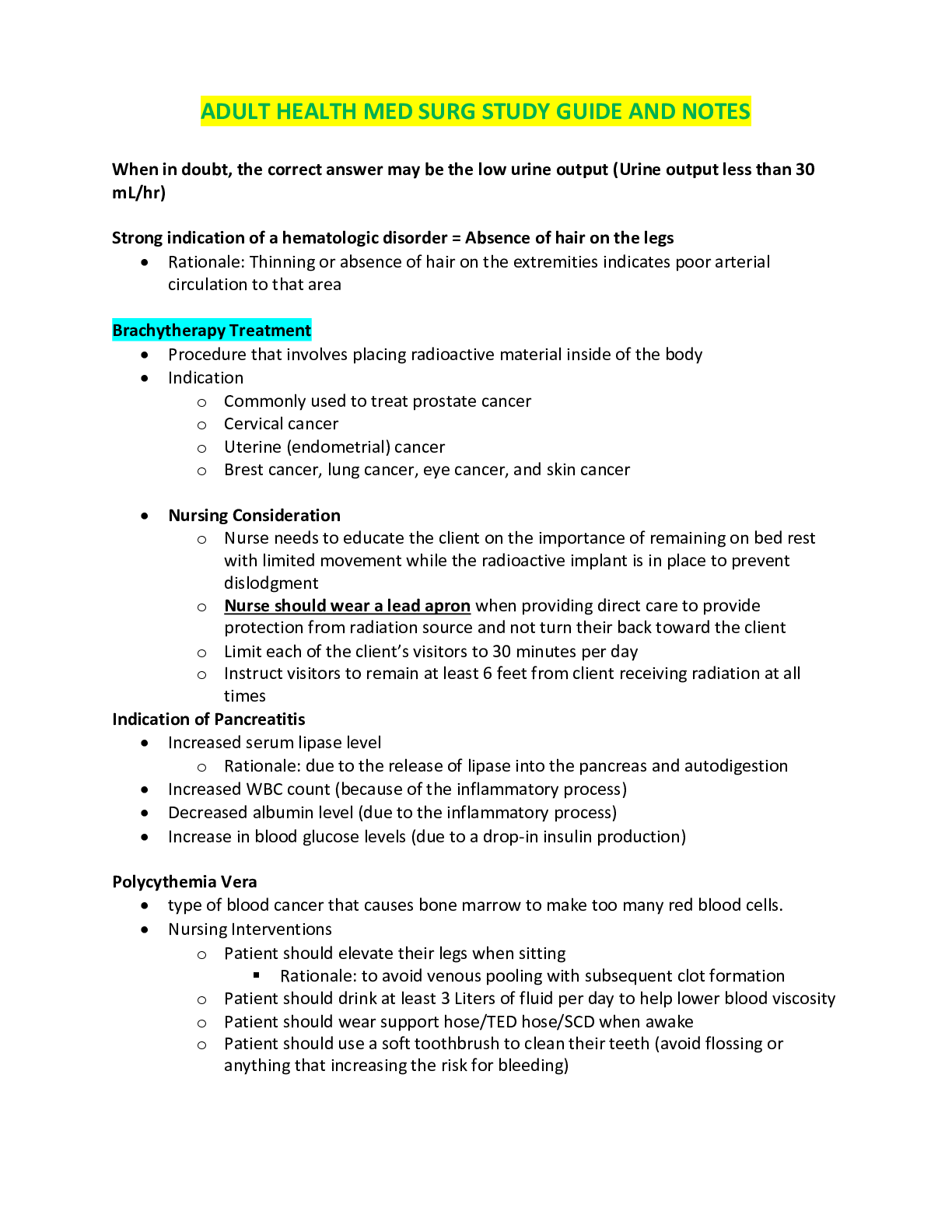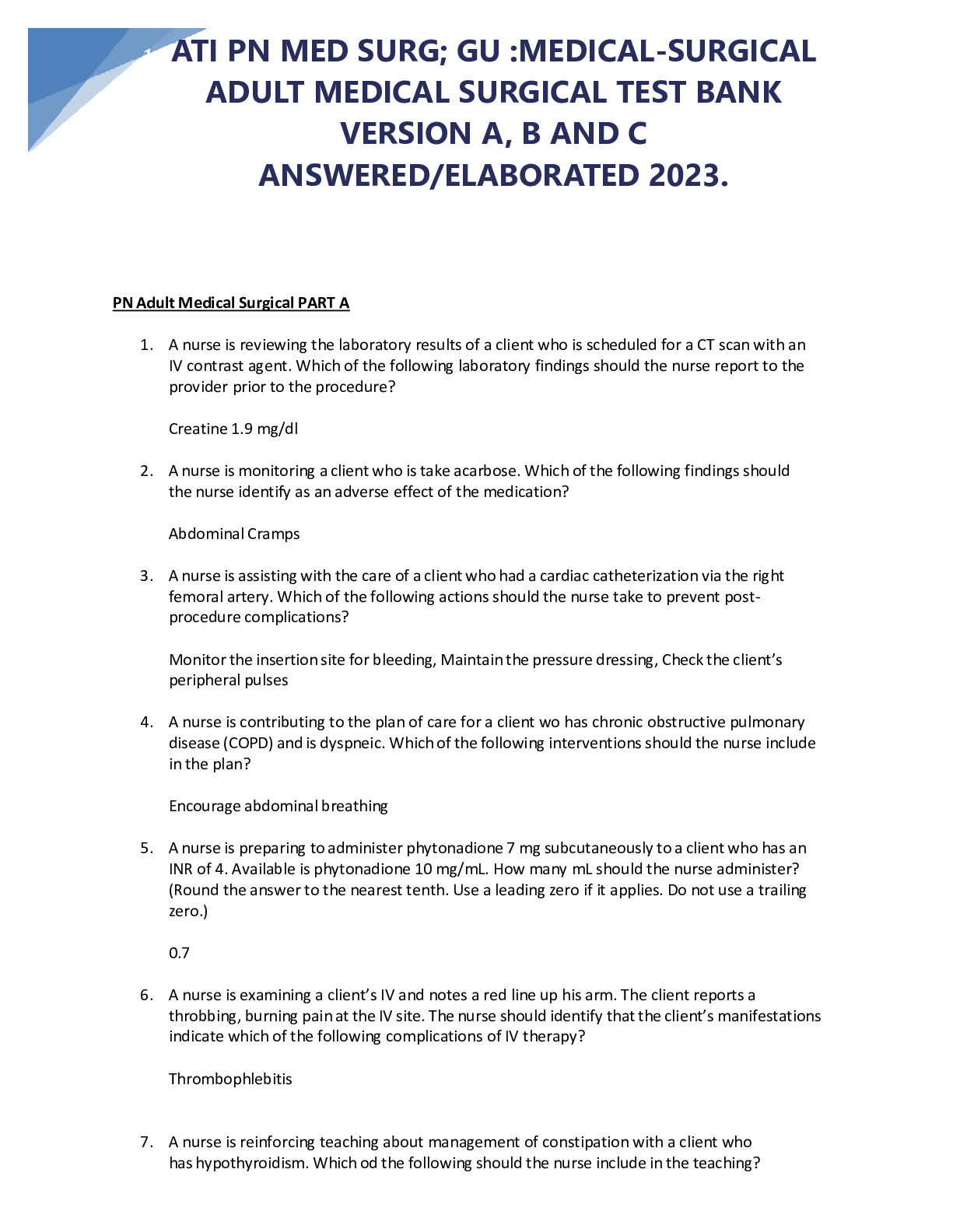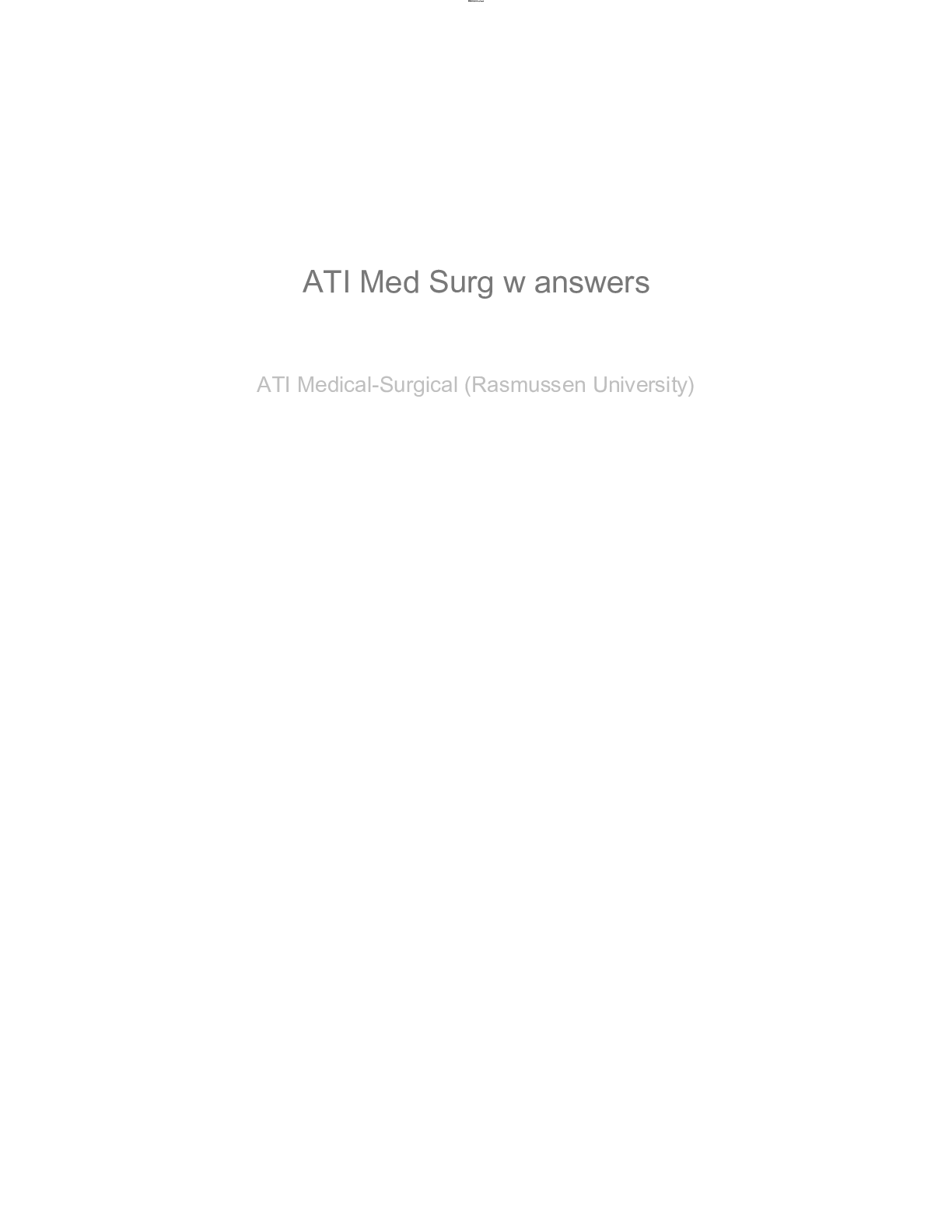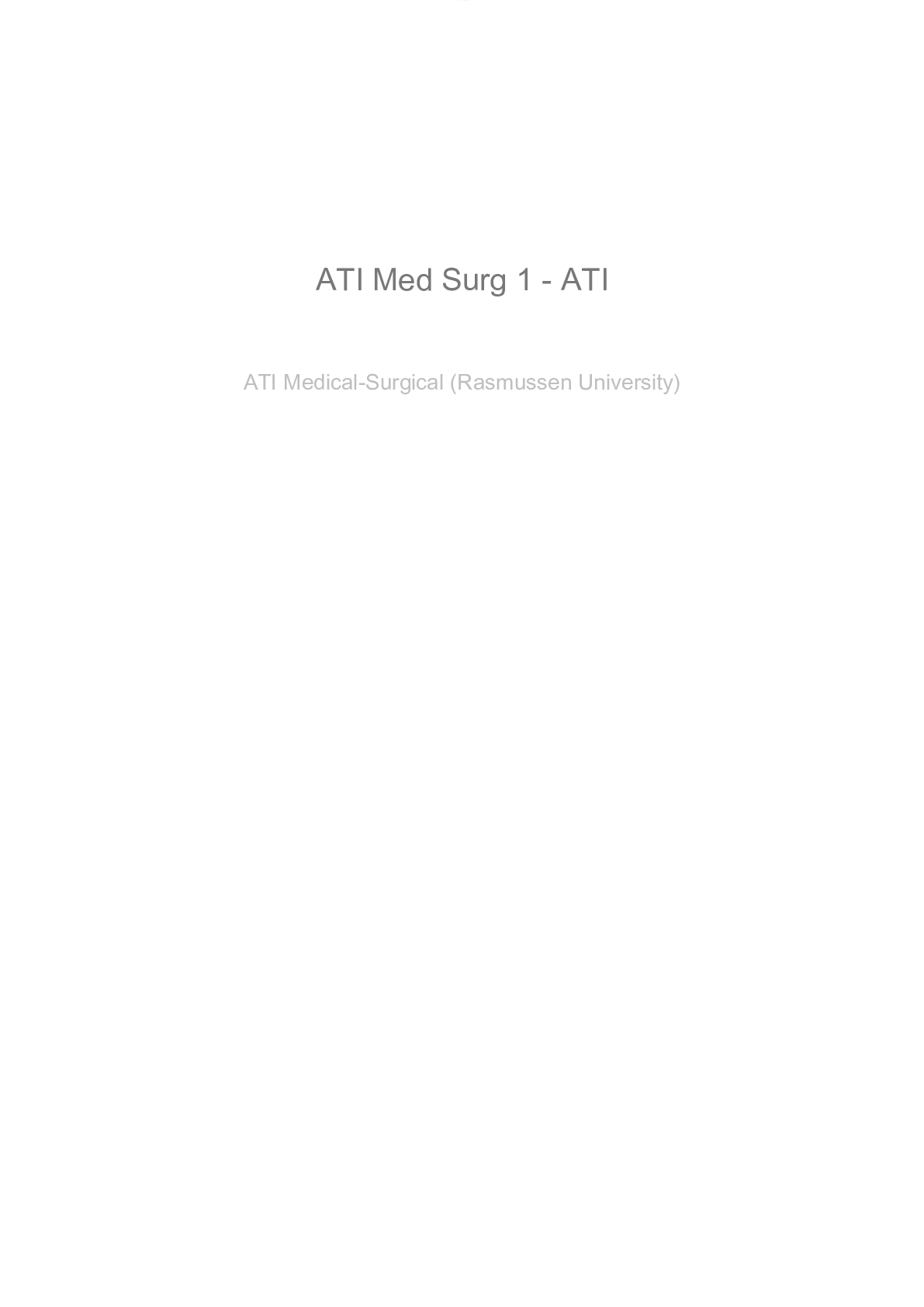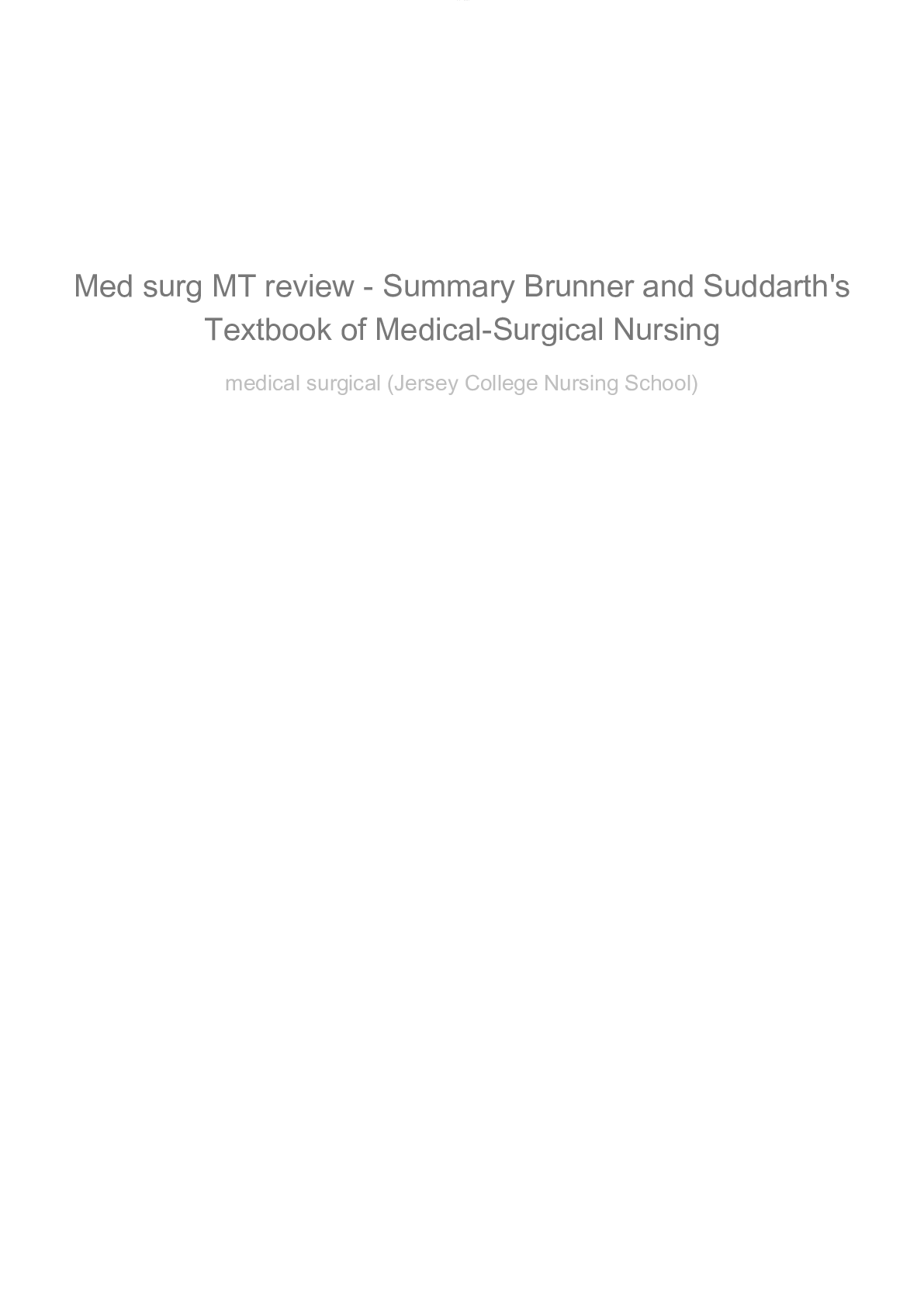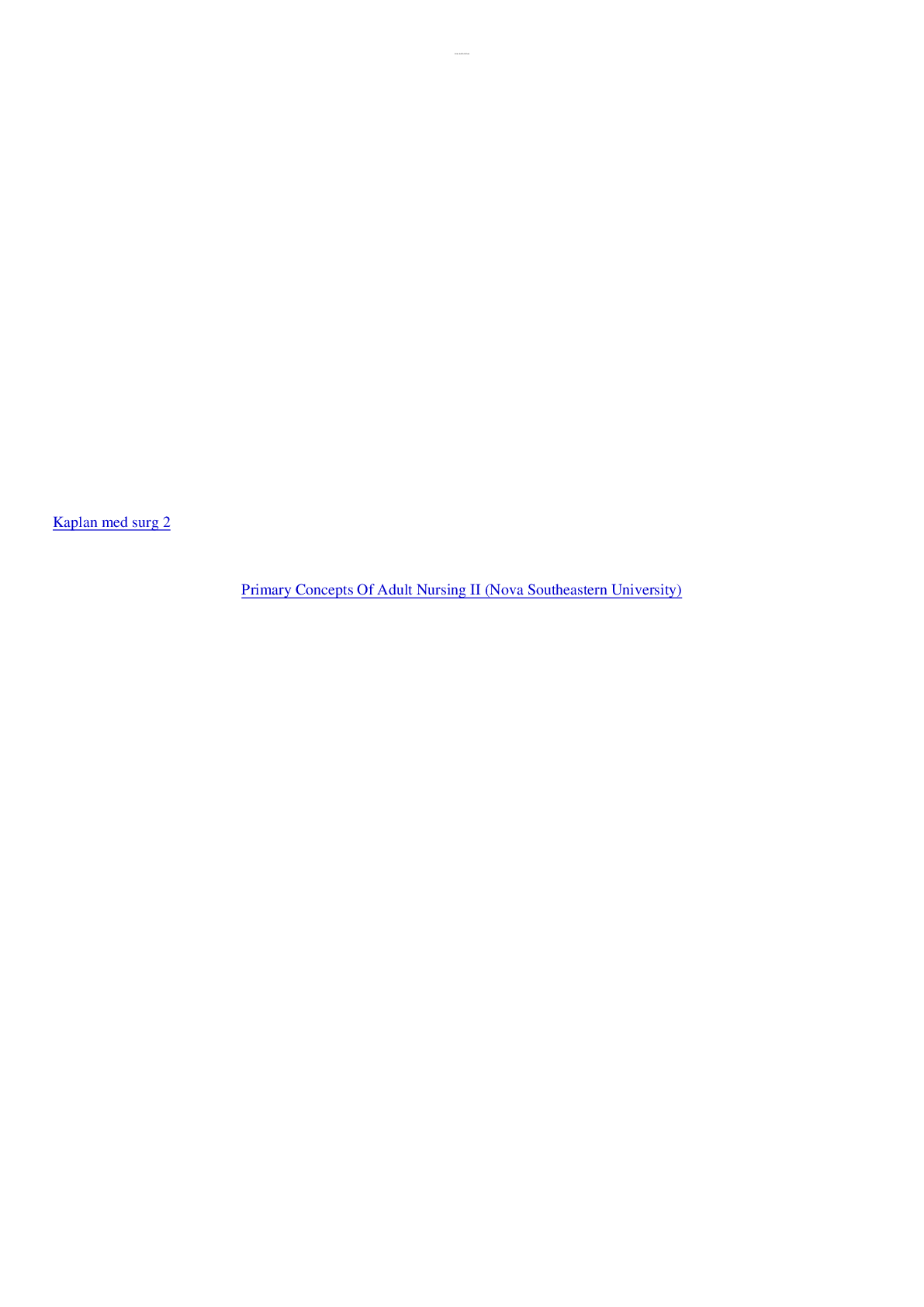*NURSING > MED-SURG EXAM > Medical Surgical Proctored ATI Exam A, Questions and answers, Graded A+, 2022 update. (All)
Medical Surgical Proctored ATI Exam A, Questions and answers, Graded A+, 2022 update.
Document Content and Description Below
Medical Surgical Proctored ATI Exam A, Questions and answers, Graded A+, 2022 update. A nurse is caring for a client who has pancreatitis. The nurse should expect which of the following lab results... to be BELOW the expected reference range? A. Amylase B. Alkaline phosphatase C. Bilirubin D. Calcium - ✔✔D. Calcium A client who has pancreatitis is expected to have a DECREASED calcium and magnesium d/t fat necrosis. The other options would all be increased. A nurse is caring for a client who has DKA. Which of the following lab findings should the nurse expect? A. negative urine ketones B. BUN 32 mg/dL C. pH 7.43 D. HCO3 23 mEq/L - ✔✔B. BUN 32 mg/dL DKA results in osmotic diuresis and subsequent dehydration. The nurse should expect a client who has DKA to have elevated BUN, creatinine, and specific gravity levels resulting from the excess glucose present in the urine. A. DKA causes ketones in the urine and blood. C. You would expect the pH to be <7.35 (because of the production of ketones) D. You would expect HCO3 <15 d/t increased production of ketones causing metabolic acidosis. A nurse is providing d/c instructions to a client who has a partial-thickness burn on the hand. Which of the following instructions should the nurse include? A. Change the dressing q 72 hr. B. Immobilize the hand with a pressure dressing. C. Take pain medication 30 min after changing the dressing. D. Wrap fingers with individual dressings. - ✔✔D. Wrap the fingers with individual dressings. The nurse should instruct the client to wrap the fingers individually to allow for functional use of the hand while healing occurs. The nurse should also instruct the client to perform range-of-motion exercises to each finger every hour while awake to promote function of the injured hand. A. q 12-24 hr B. With skin grafts, you should elevate and immobilize the graft site with cotton pressure dressings for 3-5 days following the procedure. C. 30 min before dressing change A nurse is planning care for a client who has extensive burn injuries and is immunocompromised. Which of the following precautions should the nurse include in the POC to prevent Pseudomonas aeruginosa infection? A. Encourage the client to eat raw fruits and veggies. B. Avoid placing plants or flowers in the client's room. C. Limit visitors to members of the client's immediate family. D. Wear an N95 respirator mask when providing care to the client. - ✔✔B. Avoid placing plants or flowers in the client's room. Live plants can harbor P. aeruginosa, and this bacterium can infect burn wounds and cause life-threatening complications. The nurse should ensure no one brings live plants or flowers into the client's room. A. P. aeruginosa can be found in raw fruits and veggies. C. Prohibit visits from those at risk for P. aeruginosa infections (i.e. anyone who is ill, other hospitalized clients, and small children) D. spread by contact not airborne A nurse in an ED is caring for a client who reports v/d for the past 3 days. Which of the following findings should indicate to the nurse that the client is experiencing fluid volume deficit? A. HR 110/min B. BP 138/90 mmHg C. Urine specific gravity 1.020 D. BUN 15 mg/dL - ✔✔A. HR 110/min A client who has a 3-day history of vomiting and diarrhea is likely to have fluid volume deficit and an elevated heart rate. B. WNL (would expect hypotension for this client) C. WNL (would expect >1.030 for this client) D. WNL (would expect BUN >20 for this client) A nurse in an ED is reviewing the provider's prescriptions for a client who sustained a rattlesnake bite to the lower leg. Which of the following prescriptions should the nurse expect? A. Apply ice to the client's puncture wound. B. Initiate corticosteroid therapy for the client. C. Keep the client's leg above heart level. D. Administer an opioid analgesic to the client. - ✔✔D. Administer an opioid analgesic to the client. The nurse should expect a prescription for an opioid analgesic to promote comfort following a rattlesnake bite. A. Apply ice for a bite from a black widow to reduce the action of the neurotoxin from the spider. B. Expect a prescription for antihistamines and corticosteroids from bees and wasps. C. Keep the affected extremity AT HEART LEVEL, not above or below it. A nurse is providing teaching to a client who has chronic kidney disease and a new prescription for erythropoietin. Which of the following statements by the client indicates an understanding of the teaching? A. "I should take calcium supplements so the medication will work better in my system." B. "I am taking this medication to increase my energy level." C. "This medication can cause my BP to drop." D. "I will not need to restrict protein in my diet while taking this medication." - ✔✔B. "I am taking this medication to increase my energy level." The goal of erythropoietin therapy is to increase the level of hematocrit in clients who have anemia. When the medication is effective, the client should have a decrease in fatigue and an improvement in activity tolerance. A. A client who has chronic kidney disease should have adequate iron stores for erythropoietin therapy to be effective. Clients are encouraged to consume foods high in iron such as beef, liver, pork, and veal. C. Increased RBC productions, leading to HYPERtension D. Does not affect the client's protein requirements A nurse is reviewing the lab results of a client who has cirrhosis. Which of the following lab values should the nurse expect? A. decreased prothrombin time B. elevated bilirubin level C. decreased ammonia level D. elevated albumin level - ✔✔B. elevated bilirubin level Bilirubin levels reflect the liver's ability to conjugate and excrete bilirubin, a byproduct of the hemolysis of red blood cells. Bilirubin levels rise with liver disease and clinically reflect the client's degree of jaundice. A. Liver disease and severe liver cell damage causes the liver cells to produce less prothrombin, which prolongs prothrombin time. C. Expect elevated ammonia levels because the liver converts ammonia to urea. When this is interrupted, ammonia levels rise. D. Albumin is formed in the liver. With an impaired liver function, albumin levels decrease. A nurse in a community clinic is caring for a client who reports an increase in the frequency of migraine headaches. To help reduce the risk for migraine headaches, which of the following foods should the nurse recommend the client to avoid? A. shellfish B. aged cheese C. peppermint candy D. enriched pasta - ✔✔B. aged cheese Foods that contain tyramine, such as aged cheese and sausage, can trigger migraine headaches. A. Not a common trigger. However, smoked fish and fermented or pickled foods are a common trigger. C. Not a common trigger. However, chocolate is a common trigger. D. Not a common trigger. However, yeast (an ingredient in pastries and bread) is a common trigger. A nurse is planning to provide d/c teaching for the family of an older adult client who has hemianopsia and is at risk for falls. Which of the following instructions should the nurse include? A. Keep the client's personal care items in the bathroom. B. Keep the overhead lights on in the client's bedroom while the client is sleeping. C. Remind the client to scan their complete range of vision during ambulation. D. Secure the client's extension cords under carpeting. - ✔✔C. Remind the client to scan their complete range of vision during ambulation. The nurse should instruct the family to remind a client who has hemianopsia, or blindness in half of the visual field, to use visual scanning to look over their complete range of vision during ambulation. This practice can accommodate for the loss of vision and help to reduce the risk for falls A. Keep the client's personal care items within the client's reach to reduce the risk for falls. B. Instruct the family to use nightlights in the client's bedroom and bathroom to reduce the risk for falls. Keeping the overhead lights on while the client is sleeping can disrupt the client's circadian rhythm. D. Instruct the client's family that they should secure extension cords to the client's baseboards using electrical tape to reduce the risk for falls. A nurse is providing teaching to a client who has esophageal cancer and is to undergo radiation therapy. Which of the following statements should the nurse identify as an indication that the client understands the teaching? A. "I will wash the ink markings off the radiation area after each treatment." B. "I will use my hands rather than a washcloth to clean the radiation area." C. "I will be able to be out in the sun 1 month after my radiation treatments are over." D. "I will use a heating pad on my neck if it becomes sore during the radiation therapy." - ✔✔B. "I will use my hands rather than a washcloth to clean the radiation area." The client should gently wash the radiation area with their hands using warm water and mild soap to protect the skin from further irritation. A. The ink markings designate the exact radiation area. The client should NOT remove these markings until they complete the entire radiation treatment. C. The client should avoid direct sunlight during the radiation treatments and for at least 1 year following the conclusion of the therapy. D. Avoid exposing the treatment area to heat because it can cause further irritation to the skin. A nurse is preparing a client who has supraventricular tachycardia for elective cardioversion. Which of the following medications should the nurse instruct the client to withhold for 48 hr prior to cardioversion? A. Enoxaparin B. Metformin C. Diazepam D. Digoxin - ✔✔D. Digoxin Cardiac glycosides, such as digoxin, are withheld prior to cardioversion. These medications can increase ventricular irritability and put the client at risk for ventricular fibrillation after the synchronized countershock of cardioversion A. Should not be withheld b/c anticoagulants prevent blood clots that can be released into the circulatory system after cardioversion. B. Metformin is held for procedures involving contrast dye (i.e. cardiac catheterization) in order to prevent damage to the kidneys. C. Sedatives are usually given prior to cardioversion to reduce anxiety and minimize discomfort with the procedure. A nurse in an acute care facility is caring for a client who is at risk for seizures. Which of the following precautions should the nurse implement? A. Place a padded tongue blade at the client's bedside. B. Keep the side rails lowered on the client's bed. C. Maintain the HOB at hip level or above. D. Ensure that the client has a patent IV. - ✔✔D. Ensure that the client has a patent IV. The nurse should ensure the client has IV access in the event that the client requires medication to stop seizure activity. A. Never insert a padded tongue blade into the client's mouth because it can cause injury or occlude the airway. B. Keep 2 or 3 side rails up to prevent falls. C. Keep the bed in the lowest position. A nurse in an ED is assessing a client who has a detached retina. Which of the following should the nurse expect the client to report? A. "It's like a curtain closed over my eye." B. "This sharp pain in my eye started 2 hours ago." C. "I've been having more and more difficulty seeing over the last few weeks." D. "I seem to have more problems seeing different colors." - ✔✔A. "It's like a curtain closed over my eye." A retinal detachment is the separation of the retina from the epithelium. It can occur because of trauma, cataract surgery, retinopathy, or uveitis. Clients who have retinal detachment typically report the sensation of a curtain being pulled over part of the visual field. B. With a retinal detachment, clients usually report seeing sudden flashes of light, a sensation of a curtain being pulled over the eye, or floating dark spots. However, it is usually PAINLESS. C. Sudden onset D. This occurs in clients who have cataracts. A nurse is providing teaching to a client who has a gastric ulcer and a new prescription for omeprazole. The nurse should instruct the client that the medication provides relief by which of the following actions? A. neutralizing gastric acid B. reducing the growth of ulcer-causing bacteria C. coating the stomach lining D. suppressing gastric acid production - ✔✔D. suppressing gastric acid production Omeprazole is a proton pump inhibitor. It relieves manifestations of gastric ulcers by suppressing gastric acid production. A. Antacids neutralize gastric acid. B. Antibiotics reduce the growth of ulcer-causing bacteria H. pylori. C. Anti-ulcer meds, such as sucralfate, coat the stomach lining and adhere to the ulcer site. A nurse is caring for a client who has a new dx of hyperthyroidism. Which of the following is the priority assessment finding that the nurse should report to the provider? A. Restlessness B. T3 level 215 ng/dL C. BP 170/80 mmHg D. Decreased weight - ✔✔C. BP 170/80 mmHg Using the urgent vs. nonurgent approach to client care, the nurse should determine that the priority finding is a systolic blood pressure of 170 mm Hg, which indicates that the client is at risk for thyroid storm. A. Restlessness is nonurgent b/c this is an expected finding with hyperthyroidism. B. An elevated T3 is nonurgent b/c it is an expected finding with hyperthyroidism. D. Decreased weight is nonurgent b/c it is an expected finding with hyperthyroidism. A nurse is providing dietary teaching to a client who is postoperative following a thyroidectomy with removal of the parathyroid glands. The nurse should instruct the client to include which of the following foods has the greatest amount of calcium in her diet? A. 12 almonds B. 1 small banana C. 1 tbsp peanut butter D. 1/2 cup tomato juice - ✔✔A. 12 almonds The nurse should determine that almonds are the best source of calcium to recommend because 12 almonds contain 36 mg of calcium. Removal of the parathyroid glands, which regulate calcium in the body, can result in hypocalcemia. B. 5 mg of calcium C. 8 mg of calcium D. 12 mg of calcium A nurse is preparing to administer a unit of PRBCs to a client. Which of the following actions should the nurse take? A. Remain with the client for the first 15 min of the infusion. B. Prime the blood administration IV tubing with LR. C. Verify the client's identify by using the client's room # prior to starting the transfusion. D. Infuse the unit of PRBCs within 8 hr. - ✔✔A. Remain with the client for the first 15 min of the infusion. The nurse should remain with the client for the first 15 to 30 min of the infusion because hemolytic reactions usually occur during the infusion of the first 50 mL of blood. B. 0.9% sodium chloride C. Ensure that the name and number on the client's ID band matches the name and ID number on the blood label. D. Transfuse the PRBCs within 2-4 hr. A nurse is providing teaching to a client who has IBS. Which of the following instructions should the nurse include in the teaching? A. Take an antacid before meals and at bedtime. B. Increase fiber intake at least 30 g per day. C. Drink ginger tea daily. D. Consume no more than 1 L of water per day. - ✔✔B. Increase fiber intake at least 30 g per day. Dietary fiber helps produce bulky, soft stools and establish regular bowel patterns. A. Antacids are used to manage gastric reflux and dyspepsia, not cramps and pain associated with diarrhea and constipation. C. Ginger tea is useful for treating nausea, not cramping. D. The client should consume at least 2 L of water daily to promote regular bowel function. A nurse is caring for a client who has chronic glomerulonephritis with oliguria. Which of the following findings should the nurse identify as a manifestation of chronic glomerulonephritis? A. Metabolik alkalosis B. Hyperkalemia C. Increased Hgb D. Hypophosphatemia - ✔✔B. Hyperkalemia The nurse should identify that a client who has chronic glomerulonephritis can experience hyperkalemia as a result of kidney failure. Kidney failure results in decreased excretion of potassium. A. Metabolic acidosis as a result of bicarbonate loss and retention of H+ ions. C. Expect anemia as a result of decreased RBC production. D. The client would experience hyperglycemia as a result of decreased excretion of phosphorus through the kidneys. A nurse is caring for a client who is postoperative following a total hip arthroplasty. Which of the following lab values should the nurse expect to report to the provider? A. K+ 4 mEq/L B. WBC count 10,000/mm3 C. Hct 45% D. Hgb 8 g/dL - ✔✔D. Hgb 8 g/dL The nurse should report an Hgb level of 8 g/dL, which is below the expected reference range and is an indicator of postoperative hemorrhage or anemia. A. WNL B. WNL C. WNL A nurse is planning care for a client who is undergoing brachytherapy via a sealed vaginal implant to treat endometrial cancer. Which of the following actions should the nurse include in the client's POC? A. Collect and place the client's urine or feces in a biohazard bag. B. Limit the client's ambulation to their own room. C. Wear a lead apron while providing care for the client. D. Limit each visitor to 1 hr per day. - ✔✔C. Wear a lead apron while providing care for the client. The nurse should wear a lead apron when providing direct care to provide protection from the radiation source and not turn their back toward the client, because the apron only shields the front of the body. The nurse should also wear a dosimeter film badge to measure radiation exposure. A. The client's excretions are not radioactive. B. Not only does the client require bedrest in a private room while the radiation implant is in place, but the nurse must also discourage the client from any excessive movements while in bed to prevent dislodging the implant. D. Limit each of the client's visitors to 30 min per day and instruct them to remain at least 6 ft from the client at all times. A nurse is assessing a client who had extracorporeal shock wave lithotripsy (ESWL) 6 hr ago. Which of the following findings should the nurse expect? A. stone fragments in the urine B. fever C. decreased UOP D. bruising on the lower abdomen - ✔✔A. stone fragments in the urine ESWL is an effort to break the calculi so that the fragments pass down the ureter, into the bladder, and through the urethra during voiding. Following the procedure, the nurse should strain the client's urine to confirm the passage of stones. B. Fever is considered a complication caused by a UTI or pyelonephritis. C. This is considered a complication caused by stone fragments obstructing urine flow. D. Bruising on the lower back or flank of the affected side is caused by the repeated shock waves directed toward the body during the ESWL procedure. A nurse is evaluating a client who has a new diagnosis of type 1 DM. Which of the following client statements indicates the client is successfully coping with the change? A. "It is just easier to let my partner administer my insulin." B. "I used to never worry about my feet. Now, I inspect my feet every day with a mirror." C. "I'm concerned I won't be able to read my blood sugar level because the screen is so small." D. "I know a lot of people who have diabetes and do not take insulin. I wish I didn't have to." - ✔✔B. "I used to never worry about my feet. Now, I inspect my feet every day with a mirror." A nurse is providing d/c instructions following an upper GI series with barium contrast. Which of the following info should the nurse provide? A. Increase fluid intake B. Take OTC antidiarrheal medication C. Expect black, tarry stools D. Follow a low-fiber diet - ✔✔A. Increase fluid intake Increasing fluid intake will help to prevent constipation. Therefore, the nurse should instruct the client to increase fluid intake to facilitate the elimination of the barium used during the test. B. This will slow the elimination of the barium used during the test. The nurse should instruct the client to take a laxative. C. Expect stools to appear chalky white until the barium is completely eliminated, which typically takes between 24-72 hours. Black, tarry stools are indicative of GI bleeding. D. The nurse should recommend an increase in fiber intake to help eliminate the barium. A nurse in a provider's office is caring for a client who requests sildenafil to treat erectile dysfunction. Which of the following statements should the nurse make? A. "You might need to take a stool softener while taking this medication." B. "You will not be able to use sildenafil if you have diabetes." C. "You will need to limit your caffeine intake if you start taking sildenafil." D. "You will not be able to use sildenafil if you are taking nitroglycerin." - ✔✔D. "You will not be able to use sildenafil if you are taking nitroglycerin." The client should not use sildenafil when taking nitroglycerin because both medications can cause vasodilation and lead to significant hypotension. A. It can cause diarrhea, rather than constipation. B. Clients who have renal, hepatic, or cardiovascular disease should use sildenafil cautiously. C. High-fat meals can decrease absorption of the medication. A nurse is teaching a class about client rights. Which of the following instructions should the nurse include? A. A client should sign an informed consent before receiving a placebo during a research trial. B. A client cannot refuse to sign a consent form for a life-saving treatment. C. A client who has a mental illness is unable to give informed consent. D. An unemancipated minor needs guardian consent for substance use disorder treatment. - ✔✔A. A client should sign an informed consent before receiving a placebo during a research trial. A nurse should ensure a client has provided informed consent before administering a placebo. The nurse should not administer a placebo to a client who thinks it is an active medication, because this action is a violation of client rights. B. Client has the right to refuse consent. C. Client who has a mental illness has the right to consent or refuse treatment, unless deemed incompetent by a court of law. D. This client has the right to consent to treatment for substance use disorder. A nurse in a provider's office is assessing a client who has HTN and takes propranolol. Which of the following findings should indicate to the nurse that the client is experiencing an adverse reaction to this medication? A. Report of a night cough B. Report of tinnitus C. Report of excessive tearing D. Report of increased salivation - ✔✔A. Report of a night cough The nurse should recognize that a night cough is an early indication of heart failure and report this adverse reaction to the provider. B. This drug is a nonselective beta-adrenergic antagonist that has sensory effects, including dry eyes and vision changes. Tinnitus is not an adverse effect. [Show More]
Last updated: 1 year ago
Preview 1 out of 49 pages
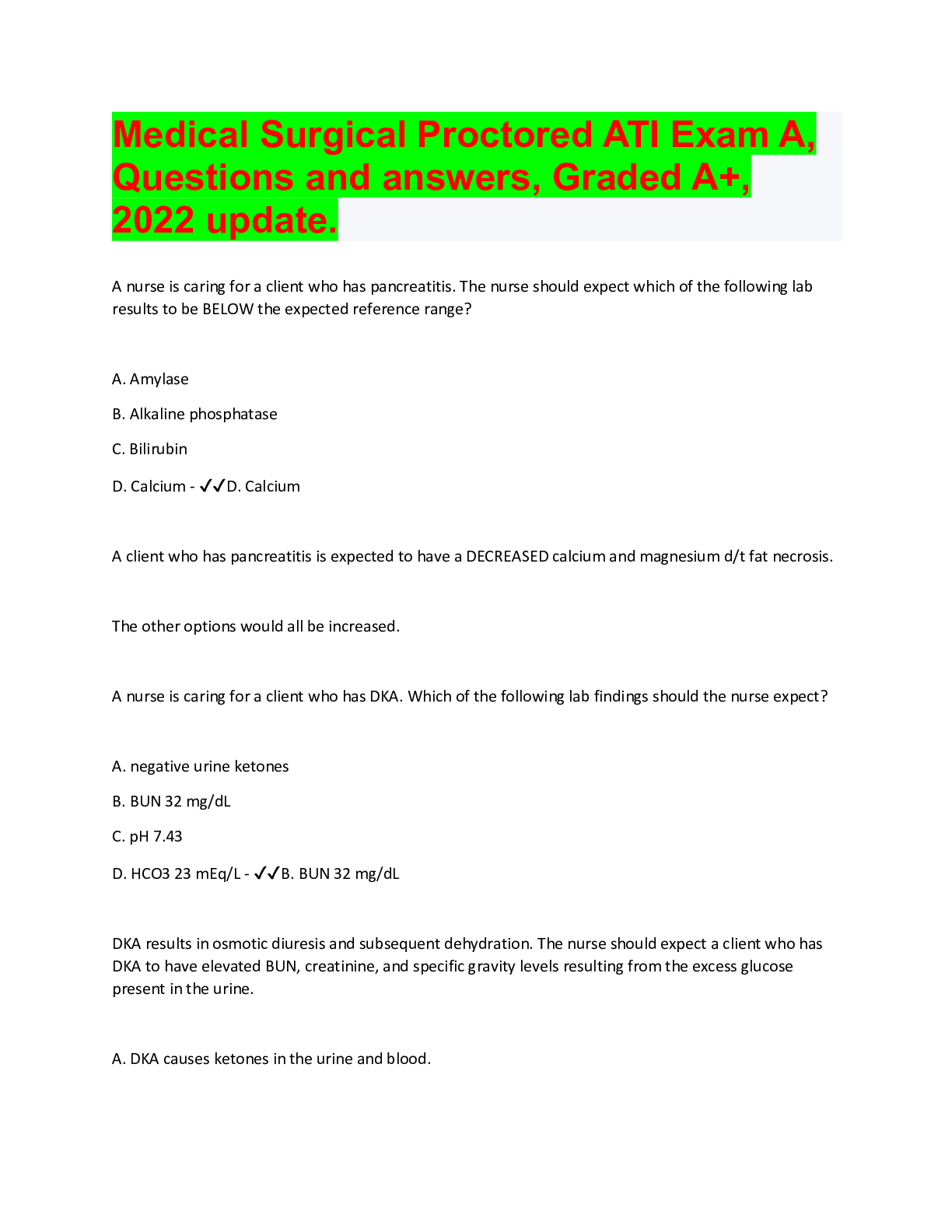
Reviews( 0 )
Document information
Connected school, study & course
About the document
Uploaded On
Aug 26, 2022
Number of pages
49
Written in
Additional information
This document has been written for:
Uploaded
Aug 26, 2022
Downloads
0
Views
92

